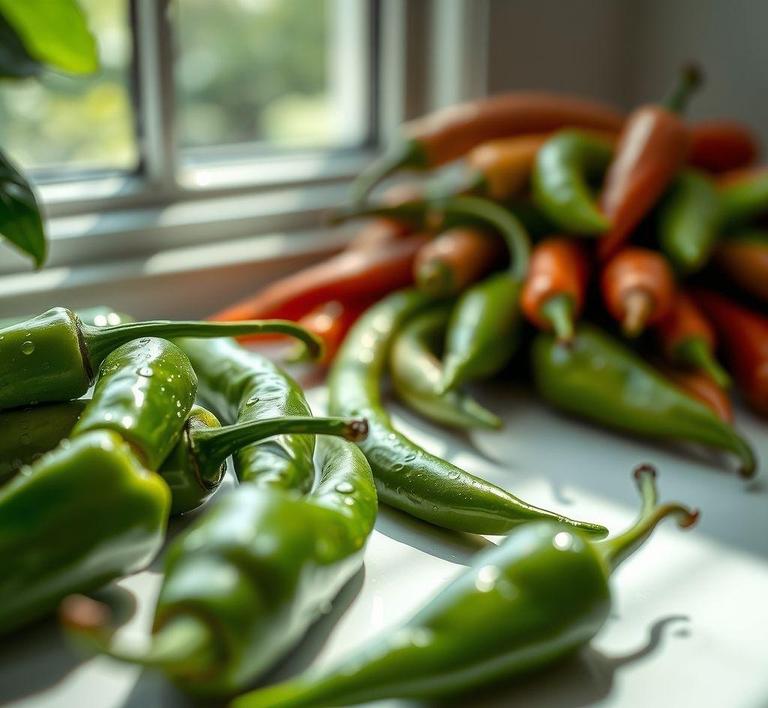If you’ve ever found yourself with an excess of green chili and wondered whether it’s possible to refreeze it, you’re not alone! Refreezing green chili can be a handy way to prevent waste and keep your favorite spicy ingredient on hand for future dishes. However, there are a few things to consider before throwing those leftover chilies back in the freezer, like their texture and flavor once thawed. In this guide, we’ll dive into the best methods for refreezing green chili, how to maintain its taste and quality, and share tips for making the most out of your chili stash. Whether you’re dealing with fresh or cooked green chilies, we’ve got you covered!
Can You Refreeze Green Chili?

When it comes to food preservation, refreezing often brings up questions about safety and quality, and green chili is no exception. Green chili, with its vibrant flavor and spicy kick, is a favorite ingredient in various cuisines, especially in Southwestern and Mexican dishes. Whether you have some leftover chili from a large batch or bought a bit too much at the grocery store, the thought of refreezing green chili might cross your mind.
The answer, in short, is yes, you can refreeze green chili, but with some important caveats. The process of freezing and refreezing can impact the texture and flavor of the chili, but as long as it is handled correctly, the chili will remain safe to eat. However, refreezing chili more than once is not recommended, as each cycle of freezing and thawing can introduce the potential for bacterial growth and a greater loss of flavor and texture. The key lies in how you freeze and thaw your chili in the first place, ensuring that the chili has not been left at room temperature for too long, which could foster harmful bacteria.
How To Refreeze Green Chili?
If you find yourself with green chili that has already been frozen and thawed, and you want to refreeze it, follow these steps carefully to preserve the best possible outcome for the chili’s safety and quality.
1. Check The Thawing Process
First and foremost, ensure that the chili was thawed properly. If the chili has been left out at room temperature for more than two hours, it should not be refrozen. The best practice is to thaw chili in the refrigerator or by using the defrost function on your microwave. If chili has been thawed improperly, it is safer to discard it rather than refreezing it.
2. Cool Down Your Chili
If the chili has been thawed, allow it to cool down to room temperature before attempting to refreeze it. However, don’t let it sit out for more than two hours. This helps reduce the risk of bacterial growth.
3. Portioning For Convenience
One of the most practical ways to freeze chili is by portioning it into small, manageable amounts. This allows you to thaw only what you need rather than thawing the entire batch and potentially wasting food. You can portion the chili into plastic containers or freezer bags, making sure to remove as much air as possible to prevent freezer burn.
4. Seal And Label
Whether you’re using plastic containers or freezer bags, make sure to tightly seal them to avoid air exposure. Air causes freezer burn, which negatively affects both the texture and flavor of the chili. Label the containers with the date it was frozen and the amount inside, so you know exactly what you’re working with when it’s time to refreeze or reheat.
5. Freeze Quickly
The quicker the chili is refrozen, the better. Place it back into the freezer as soon as possible after portioning and sealing. It’s important to ensure that the freezer temperature is at or below 0°F (-18°C) to maintain the chili’s safety and quality during storage.
6. Limit Refreezing
As mentioned earlier, it’s important not to make a habit of refreezing green chili. Refreezing multiple times will cause it to lose more moisture and result in a mushier texture upon reheating. If possible, use the chili within a few weeks of refreezing for the best results.
Quality Impact
Refreezing green chili does affect its quality, primarily in terms of texture and flavor. Let’s break this down in detail:
1. Texture Changes
One of the most noticeable effects of freezing and refreezing green chili is the change in texture. Fresh green chili has a crisp, slightly firm texture, but once frozen and thawed, the water in the chili expands, causing the cell walls to break down. This can make the chili more limp, soggy, and soft after reheating. When you refreeze it, these effects can be compounded, leading to a more mushy consistency. The chili will still taste fine, but the texture might be unappealing, especially in dishes where the chili is used as a fresh, crunchy topping.
2. Flavor Loss
Green chili is known for its bold, spicy, and slightly smoky flavor. Freezing can dull these flavors somewhat, as the freezing process halts the natural chemical reactions that give food its fresh taste. The more times chili is frozen and thawed, the greater the loss of its vibrant flavor. While the chili may still pack a punch of heat, it might not have the same depth or brightness that it did when it was freshly cooked or stored in the freezer.
3. Moisture Loss
Freezing and refreezing result in the loss of moisture in the chili. As the chili is frozen, ice crystals form, which can cause the chili to lose some of its water content. When it’s thawed and reheated, you may notice a watery texture or that it becomes drier than it was before being frozen. When refreezing, the process exacerbates moisture loss, making the chili even drier or less appetizing.
4. Bacterial Growth Concerns
Each cycle of freezing and thawing can present a risk of bacterial growth if the chili is not handled properly. Improper thawing or extended periods in the danger zone (40-140°F or 4-60°C) can promote bacteria like Salmonella or E. coli to grow. These harmful pathogens thrive in food left at improper temperatures, making it crucial to follow safe thawing practices to prevent contamination.
Refreezing green chili is not inherently dangerous if done with care, but it does come with certain risks to the flavor, texture, and overall quality of the dish. Freezing and thawing once is perfectly safe, but the more times it’s done, the more the chili will degrade. To maximize its flavor and texture, it’s best to freeze green chili only once, portion it out for easy access, and make sure it is thawed and refrozen in a safe manner.
If you plan to use your chili in cooked dishes where the texture isn’t as important, refreezing might not be as big of an issue. However, for those looking to preserve the chili’s fresh taste and crunch, you might want to stick to freezing it only once and using it promptly after thawing. Always remember to practice safe food handling to ensure that your chili remains both safe to eat and as flavorful as possible.
Is It Safe To Refreeze Green Chili?
Refreezing green chili is a topic that tends to generate some debate among culinary enthusiasts and home cooks alike. The short answer is yes, it is generally safe to refreeze green chili as long as it has been properly stored and handled. However, the safety of refreezing hinges on a few key factors: the way the chili was initially frozen, how it has been thawed, and the quality of the chili before refreezing.
When green chili is initially frozen, the process locks in its flavor, texture, and nutritional value. If it is kept in the freezer for a short amount of time-preferably under three months-the chances of refreezing without major issues are high. This is especially true if it hasn’t been thawed and left at room temperature for extended periods. The critical point to keep in mind is the temperature fluctuation: thawing and refreezing multiple times can promote the growth of harmful bacteria, which could potentially lead to foodborne illnesses.
The texture and flavor of green chili, however, can suffer from refreezing. As with most vegetables, freezing and thawing causes cellular structure to break down, leading to a loss of crispness or firmness once it’s reheated. The chili may become softer or mushier, and if any excess moisture from the thawing process hasn’t been drained, the refrozen chili could end up too watery or limp in texture.
Signs That Green Chili Should Not Be Refrozen
Knowing when to discard or avoid refreezing green chili is just as important as knowing when it’s safe to do so. Several signs can indicate that the chili has either gone bad or is no longer suitable for refreezing:
- Off Smell or Sour Odor: One of the first red flags to look for is a change in the smell. Fresh green chili has a sharp, slightly peppery scent, but if it develops a sour or off-putting smell, it’s a sign that bacterial growth may have occurred. Thawed chili that has an unpleasant odor should never be refrozen.
- Mushy Texture or Excessive Liquid: After thawing, if the chili is mushy, overly soft, or has a significant amount of liquid surrounding it, it’s best to avoid refreezing. This could indicate that the chili has begun to break down beyond a point where the texture will be acceptable upon reheating.
- Visible Signs of Freezer Burn: Freezer burn occurs when air comes into contact with food, causing dehydration and oxidation. If your green chili has visible ice crystals or discolored, dry patches, it has been improperly stored and should not be refrozen. Freezer-burned chili will lack flavor and have a poor texture when reheated.
- Thawing Time Exceeds Safe Limits: Green chili that has been thawed for more than 2 hours at room temperature is no longer safe for refreezing. This applies to any food-when it reaches a temperature between 40°F and 140°F (the danger zone for bacterial growth), it can rapidly become unsafe. Always thaw chili in the refrigerator or using quick methods like a microwave, and never leave it out in the open air for too long.
- Changes in Color: Green chili should retain its vibrant color after freezing and thawing. If you notice that it has turned a dull brown or yellow, this could be an indication of spoilage or improper freezing, making it unsuitable for refreezing.
Common Refreezing Mistakes
Even experienced cooks can make mistakes when it comes to refreezing chili. Here are some common missteps to avoid:
- Thawing at Room Temperature: One of the biggest mistakes is thawing chili on the countertop, which allows it to stay in the temperature danger zone for too long. Bacteria thrive in this range, and allowing food to thaw at room temperature for extended periods can lead to contamination. Always thaw in the fridge or use rapid methods.
- Refreezing Without Proper Packaging: When refreezing chili, inadequate packaging is a recipe for freezer burn and flavor loss. If the chili is not stored in an airtight container or tightly sealed bag, it will be exposed to air, causing it to dry out and lose its flavor.
- Refreezing Multiple Times: Each time chili is thawed and refrozen, it undergoes additional breakdown in texture and flavor. Refreezing should only be done once-repeated cycles of freezing and thawing will lead to a loss of quality. In some cases, it can even increase the risk of contamination.
- Not Draining Excess Liquid: Chili, especially when it’s vegetable-heavy, tends to release water as it thaws. If this liquid is not drained properly before refreezing, it can cause the chili to become soggy and watery when reheated.
- Freezing Large Quantities: Freezing chili in large portions can result in uneven thawing and refreezing. It’s always best to freeze chili in smaller, portion-sized containers, which makes it easier to thaw only the amount needed at a time. This prevents you from needing to refreeze the entire batch, thus preserving its quality.
Tips And Tricks
Refreezing green chili can be done effectively if you follow a few simple tips:
- Cool Chili Before Freezing: Allow your chili to cool completely before placing it in the freezer. Hot food can raise the temperature of the freezer, increasing the risk of bacterial growth, and it can cause condensation, which leads to freezer burn.
- Use Vacuum Sealing: Vacuum-sealing your chili is one of the best ways to ensure it stays fresh and free from freezer burn. By removing all the air from the packaging, vacuum-sealing minimizes oxidation, helping the chili retain its flavor and texture.
- Label and Date Your Containers: Always label your chili with the date it was frozen. This way, you can keep track of how long it’s been in the freezer. Ideally, consume the chili within 3-4 months of freezing to maintain its best quality.
- Avoid Freezing Spicy Chili for Too Long: Chili with a higher spice content may lose some of its heat and intensity after being frozen and refrozen. If you’re making a particularly spicy chili, it’s better to eat it fresh or freeze it for a short period to retain the full flavor profile.
- Thaw in the Refrigerator: The safest method to thaw chili is in the fridge. This keeps the temperature consistent and prevents bacteria growth. Alternatively, you can reheat it directly from frozen using low heat to ensure it’s safe and still delicious.
- Freeze in Portion Sizes: To avoid the need for refreezing, consider freezing your chili in smaller portions. This way, you can thaw exactly what you need, ensuring that you don’t have to deal with leftovers that need to be frozen again.
Conclusion
Refreezing green chili is safe under the right conditions, but it requires some care to avoid compromising its quality or safety. Thawing, handling, and packaging are all important steps to consider if you want to preserve the taste and texture of your chili. Signs of spoilage, like off smells, mushiness, and discoloration, should be clear indicators that refreezing is not an option. Similarly, avoiding common mistakes such as thawing at room temperature or improperly sealing your chili can help ensure the best outcome.
Ultimately, while it’s possible to refreeze green chili, it’s a practice best done sparingly. The more you understand about proper freezing techniques, the better you’ll be able to store and enjoy your chili long after its initial cooking.


